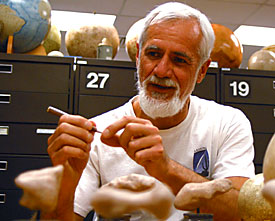 |
|
DAVID HARDEN/Arizona Daily Wildcat
|
Senior research specialist Joe Montani admires model asteroids in the Kuiper Space Sciences building. Montani is part of the Spacewatch Project, which includes a team of scientists that is responsible for discovering asteroids.
|
|
By Joshua Sills
Arizona Daily Wildcat
Tuesday March 4, 2003
Six years ago, Joe Montani discovered two new asteroids, but until last month, they floated through space ÷ nameless.
He discovered Manhattan on Jan. 2, 1997 and Perth Amboy the next day, but the International Astronomical Union did not allow him to officially name them until this year.
"It takes the IAU about five years after it's discovered to give you the go-ahead to name your object," Montani said.
Montani named his asteroids, which are located in the main asteroid belt between Mars and Jupiter, after two cities important to his life.
Perth Amboy is the small New Jersey town where Montani was born and his love of astronomy began.
"The funny thing is Perth Amboy the asteroid is about the same size (5 km across) as the town," Montani said.
The other asteroid, Manhattan, which is 8 km across, was named to honor the New York City borough attacked on Sept. 11 and to pay tribute to Columbia University, where Montani earned his bachelor's degree.
"These places hold special meaning for me," Montani said. "It's weird to think of Broadway and 120th Street as a place for a telescope, but that is where the Columbia physics building is."
Throughout his career, Montani said he has discovered a plethora of planetary objects, although he could not remember the exact number. He has been able to name 15 of them.
Montani discovered Perth Amboy and Manhattan during an observation for the Spacewatch Project, which focuses primarily on observing near-Earth objects.
"We survey the solar system for asteroids and comets," said Robert McMillan, associate research specialist for the Spacewatch Project.
The concept for the project began in the Î50s when current UA professor of planetary sciences Tom Gehrels was a student. He started out using photographs to observe objects in space, but began using electronic devices when they became available in the Î70s.
"It made it 100 times better," Gehrels said.
Gehrels met with McMillan in the late '70s, and they began seeking funding in 1980.
Montani did not join the project until 1994, after switching over from another project at the Lunar and Planetary Laboratory, where Spacewatch is located.
"I began with a project at an infrared spectroscopy lab at LPL," Montani said. "It ended and Spacewatch needed someone who worked in optics, and I did."
Montani has not discovered any new asteroids since 1997.
"There isn't one at this point in time that is suspect," Montani said. "We try to find ones that could hit earth 25 to 50 years in advance."
"Not one out of the 800 are being looked at as suspect," Montani said. "The IAU releases a list though of a 150 to 200 possibly hazardous objects."

